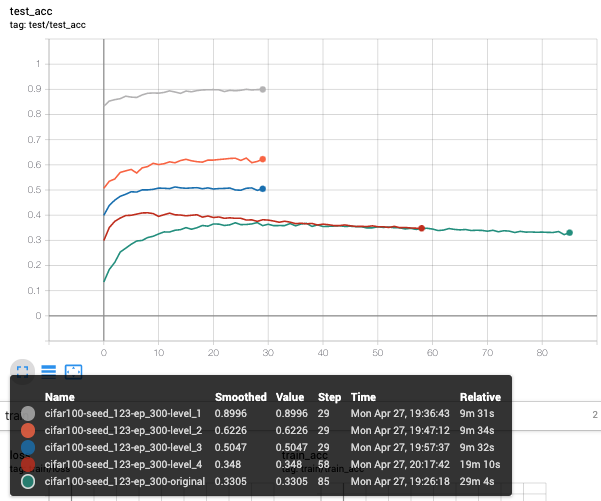This code repository contains an implementation of the work described in:
To cite this work please use the following citation:
@inproceedings{coarse-to-fine:2020,
title={{Coarse-to-Fine Curriculum Learning for Classification}},
author={Stretcu, Otilia and Platanios, Emmanouil Antonios and Mitchell, Tom and P{\'o}czos, Barnab{\'a}s},
booktitle={International Conference on Learning Representations (ICLR) Workshop on Bridging AI and Cognitive Science (BAICS)},
year={2020},
}The code is organized into the following folders:
- data: contains classes and methods for loading and preprocessing data.
- learning:
- models.py: model architectures implementations.
- trainer.py: a class in charge of training a provided model.
- hierarchy_computation.py: code for computing the label hierarchy.
- utils: other utility functions, including our implementation of the Affinity clustering algorithm.
More details can be found in our paper, video & slides,
Our code was implemented in Python 3.7 with Tensorflow 1.14.0 using eager execution. It also requires the following Python packages:
- matplotlib
- numpy
- tensorflow-datasets
- tqdm
- urllib
- yaml
Our code currently supports the datasets included in the tensorflow-datasets package, as well as Tiny ImageNet and the synthetic Shapes dataset described in our paper.
To run on tensorflow-datasets such as CIFAR-100, from the base repository folder run the command:
python3.7 -m src.run \
--dataset=cifar100 \
--normalization=normTo run on the Shapes dataset, from the base repository folder run the command:
python3.7 -m src.run \
--dataset=shapes \
--data_path=data/shapes \
--normalization=normWe provide the Shapes dataset used in our experiments in
the folder data/shapes.
To run on the Tiny ImageNet dataset, from the base repository folder run the command:
python3.7 -m src.run \
--dataset=tiny_imagenet \
--data_path=data/tiny_imagent \
--normalization=normThis will automatically download the Tiny ImageNet dataset
from the official website to the folder specified by the
--data_path flag.
Note that our code offers a range of commandline arguments,
which are described in run.py. An important argument is
normalization which specifies what type of preprocessing
to perform on the data (e.g, in the examples above
--normalization=norm specifies that inputs should be
converted from integer pixels in [0, 255] to float numbers
in [0, 1]).
Another useful argument is max_num_epochs_auxiliary which
can limit the maximum number of epochs for each of the
auxiliary functions (when training on coarser labels). In
our experiments we set this to a number lower than
num_epochs.
We recommend running on a GPU. With CUDA, this can be done
by prepending CUDA_VISIBLE_DEVICES=<your-gpu-number> in
front of the run command.
To visualize the results in Tensorboard, use the following
command, adjusting the dataset name accordingly:
tensorboard --logdir=outputs/summaries/cifar100
An example of such visualization on the CIFAR-100 dataset is the following:
The command we ran for this experiment was:
python3.7 -m src.run \
--dataset=cifar100 \
--normalization=norm \
--num_epochs=300 \
--max_num_epochs_auxiliary=30 \
--max_num_epochs_no_val_improvement=50The image above shows the accuracy per epoch on the test set for the baseline model trained without curriculum (the model with the suffix "original" [green]), as well as the accuracy of the curriculum models trained at each level of the label hierarchy (identified through the suffixes "level_1" [grey], "level_2" [orange], etc.). The model trained at the highest level ("level_4" in this case [red]) is trained on the original label space, and is thus comparable to the "original" [green] model.
